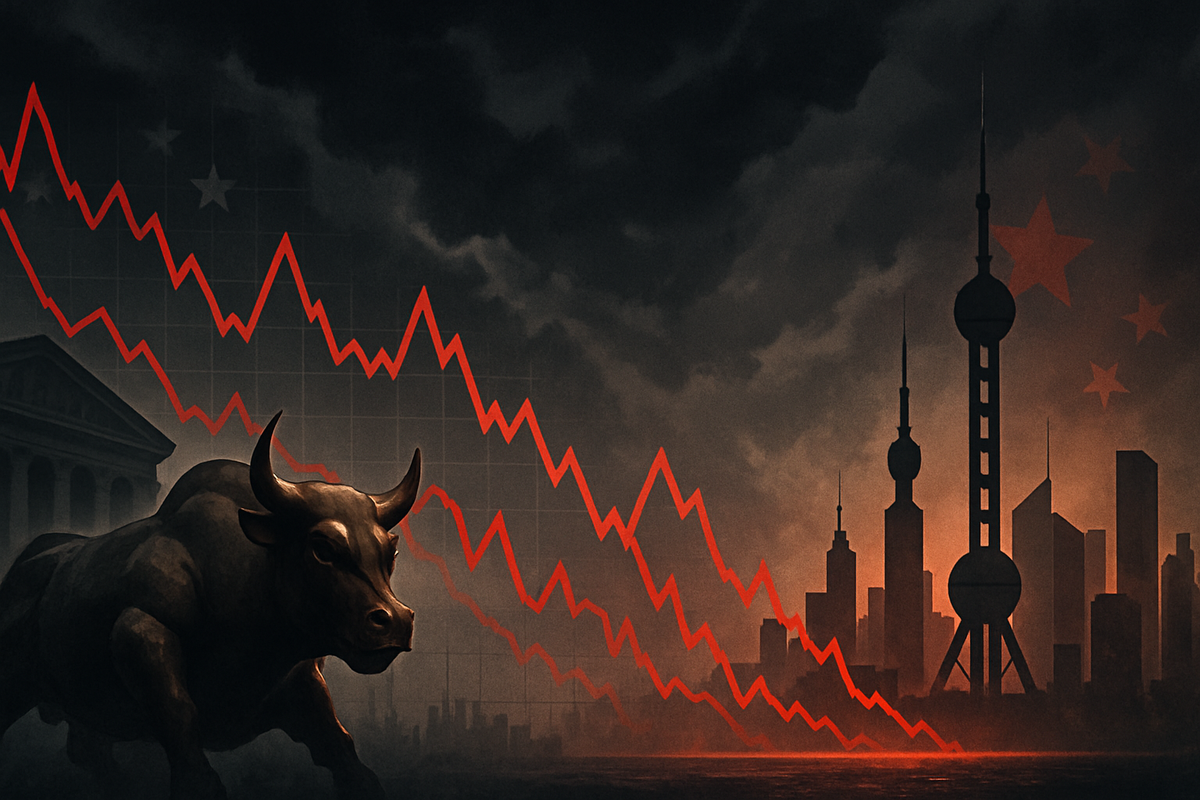
Global markets are reeling from a fresh wave of trade tensions between the United States and China, triggering a significant selloff in Chinese equities and broader global indices. As of mid-October 2025, investors are grappling with heightened uncertainty, prompting a flight to safe-haven assets and a sharp re-evaluation of risk. While the immediate implications point to market volatility and investor apprehension, some analysts are beginning to view this downturn as a potential 'buy the dip' opportunity, banking on the resilience of the Chinese economy and the high costs of a prolonged conflict for both nations.
The resurgence of protectionist rhetoric and tit-for-tat trade restrictions has shattered a period of relative calm, reversing earlier optimism that had fueled a strong rally in Chinese stocks throughout 2025. This sudden escalation is forcing a critical reassessment of global supply chains and economic interdependencies, casting a long shadow over the future of international trade and investment.
The Latest Flashpoint: Tariffs, Controls, and Retaliation
The current escalation in US-China trade tensions ignited around October 9-11, 2025, following a series of assertive moves from both Beijing and Washington. China initiated the recent round by expanding its export controls on critical rare earth materials, including production technologies, equipment, and specific rare earth elements, effective October 9. This move was widely interpreted as a direct response to earlier US trade restrictions and calls from American lawmakers for broader bans on chipmaking equipment exports to China. Further, reports indicated China imposed reciprocal port fees on US vessels and launched an antitrust investigation targeting the prominent US chipmaker Qualcomm (NASDAQ: QCOM).
In response, US President Donald Trump escalated the rhetoric, threatening a "massive" increase in tariffs. He proposed an additional 100% tariff on Chinese goods, slated to commence on November 1, and signaled potential export controls on "critical software" from American companies, describing China's actions as "hostile." Trump also publicly questioned the necessity of an anticipated meeting with Chinese leader Xi Jinping, though later remarks suggested an openness to a deal. These threats followed previous US tariffs implemented in April 2025, setting the stage for the current market turmoil.
The immediate market reaction was swift and severe. On October 10-11, major US indexes saw significant declines, with the Nasdaq Composite tumbling 3.6% (820 points), marking one of its worst days since May or April. All three major US indexes (Dow Jones Industrial Average, S&P 500, Nasdaq Composite) registered weekly losses of at least 2.4%. Chinese and Hong Kong markets were equally hit, with Hong Kong's Hang Seng Index falling 1.1% on October 10 and further by 2.49% on October 13, marking its sixth consecutive day of losses. China's blue-chip CSI300 Index dropped 1.3%, and the Shanghai Composite Index fell 0.5% on October 10. Technology and AI stocks bore the brunt of the selloff, with the CSI Semiconductor Index falling between 4.1% and 5%. The CBOE Volatility Index (VIX) spiked, reflecting heightened investor anxiety, while safe-haven assets like gold and US Treasuries gained traction.
Companies Caught in the Crossfire: Winners and Losers
The renewed trade tensions are creating a distinct set of winners and losers across various sectors, particularly for companies with significant exposure to either the US or Chinese markets, or those deeply embedded in global supply chains.
Chinese technology and semiconductor companies are particularly vulnerable. The expanded rare earth export controls, while designed to exert pressure, could also disrupt their own access to crucial components if retaliatory measures from other nations limit their supply chains. Companies like Semiconductor Manufacturing International Corporation (SMIC) (HKEX: 0981) and Hangzhou Hikvision Digital Technology Co., Ltd. (SZSE: 002415) could face increased scrutiny and restricted access to advanced Western technology. Similarly, China's burgeoning Electric Vehicle (EV) sector, which had seen robust growth, is now facing headwinds, with the New Energy Vehicles Index experiencing a significant decline.
On the American side, tech giants with substantial manufacturing operations or sales in China are at risk. Qualcomm (NASDAQ: QCOM), already facing an antitrust probe in China, stands to lose significant market share and revenue. Other semiconductor firms such as Nvidia (NASDAQ: NVDA) and Advanced Micro Devices (NASDAQ: AMD), along with e-commerce and cloud computing leader Amazon (NASDAQ: AMZN), could see their access to the lucrative Chinese market curtailed or face increased operational costs due to tariffs and export controls. Companies heavily reliant on Chinese manufacturing for their products, from consumer electronics to apparel, will also grapple with higher input costs and supply chain disruptions. Conversely, companies with diversified supply chains or those focused on domestic production within their respective countries might prove more resilient. Furthermore, sectors less directly exposed to the immediate trade dispute, or those that could benefit from a shift towards domestic sourcing, might emerge as relative winners in the long run.
Broader Implications and Historical Parallels
This latest escalation in trade tensions transcends immediate market fluctuations, signaling a more profound shift in global economic dynamics. It accelerates the trend of deglobalization, pushing companies to re-evaluate and diversify their supply chains away from a concentrated reliance on any single nation, particularly China. Initiatives like "reshoring" or "friend-shoring" are likely to gain further momentum, potentially leading to higher production costs but also increased supply chain resilience. The ripple effects extend beyond direct trade, impacting global GDP growth, inflation, and consumer prices as businesses absorb or pass on increased costs. Other nations, caught between the two economic superpowers, may face pressure to align their trade policies, potentially leading to a more fragmented global trading system.
Regulatory and policy implications are also significant. Governments are likely to implement stricter export controls on critical technologies and materials, intensify scrutiny of foreign investments, and promote greater economic nationalism. This environment could foster greater domestic innovation and production in strategic sectors but also risks stifling global collaboration and efficiency. Historically, the current situation draws parallels to the 2018-2019 US-China trade war, which saw similar cycles of tariff threats, retaliatory measures, and market volatility. While that period eventually led to a "Phase One" trade deal, the current context, with China's expanded export controls on rare earths, suggests a more strategic and potentially entrenched competition over critical resources and technological dominance. The current tensions also underscore a broader geopolitical rivalry that extends beyond mere trade imbalances, encompassing technological supremacy and national security.
What Comes Next: Navigating Uncertainty
The immediate future points to continued market volatility as investors closely monitor diplomatic developments. The prospect of a meeting between President Trump and President Xi later in October is a critical event that could either de-escalate tensions or confirm a path towards a more entrenched trade conflict. Short-term, companies will likely focus on mitigating immediate impacts, such as securing alternative suppliers or adjusting pricing strategies.
In the long term, companies are expected to undertake more fundamental strategic pivots, reassessing their global footprints and investment decisions. This could lead to a more fragmented global economy, characterized by regional trade blocs and a continued push for technological decoupling between the US and China. However, this period of disruption also presents potential market opportunities. Many analysts, including those observing the current downturn, view the selloff in Chinese stocks as a potential "buy the dip" moment. They argue that the fundamental growth drivers of the Chinese economy remain strong, and that a prolonged, all-out trade war is economically damaging for both sides, making a de-escalation or managed resolution more likely in the medium term. Investors with a higher risk tolerance and a long-term perspective might look for undervalued Chinese companies with strong domestic market exposure or those demonstrating resilience in adapting to the new trade landscape.
A New Era of Strategic Competition
The recent selloff in Chinese stocks due to renewed trade tensions underscores a critical juncture in global finance and geopolitics. The key takeaway is that the era of unfettered globalization is giving way to one of strategic competition, where trade and technology are increasingly weaponized. While the immediate market reaction has been one of fear and uncertainty, the underlying dynamics suggest a complex interplay of risks and opportunities.
Moving forward, the market will remain highly sensitive to any statements or actions from Washington and Beijing. Investors should closely watch for progress (or lack thereof) in diplomatic talks, key economic data releases from both countries, and particularly, the quarterly earnings reports of companies significantly exposed to US-China trade. These reports will provide crucial insights into how businesses are coping with the evolving trade environment. Ultimately, the lasting impact of this period may be a permanent reshaping of global supply chains and a more resilient, albeit potentially less efficient, international economic order. Investors should prepare for continued turbulence but also be alert to the strategic opportunities that emerge from this evolving landscape.
This content is intended for informational purposes only and is not financial advice



